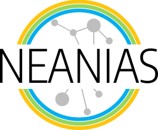The work “First Detection of Silicon-bearing Molecules in η Car“, with the support of NEANIAS project, has been published in The Astrophysical Journal Letters.
Authors
C. Bordiu, J. R. Rizzo, F. Bufano, G. Quintana-Lacaci, C. Buemi, P. Leto, F. Cavallaro, L. Cerrigone, A. Ingallinera, S. Loru, S. Riggi, C. Trigilio, G. Umana, and E. Sciacca
DOI 10.3847/2041-8213/ac9b10
Abstract
We present ALMA band 6 observations of the luminous blue variable η Car obtained within the ALMAGAL program. We report SiO J = 5 → 4, SiS J = 12 → 11, and SiN N = 5 → 4 emission in the equatorial region of the Homunculus nebula, constituting the first detection of silicon- and sulfur-bearing molecules in the outskirts of a highly evolved, early-type massive star. The SiO, SiS, and SiN trace a clumpy equatorial ring that surrounds the central binary at a projected distance of ∼2'', delineating the inner rims of the butterfly-shaped dusty region. The formation of silicon-bearing compounds is presumably related to the continuous recycling of dust due to the variable wind regime of η Car, which destroys grains and releases silicon back to the gas phase. We discuss possible formation routes for the observed species, contextualizing them within the current molecular inventory of η Car. We find that the SiO and SiS fractional abundances in localized clumps of the ring, 6.7 × 10−9 and 1.2 × 10−8, respectively, are exceptionally lower than those measured in C- and O-rich AGB stars and cool supergiants, while the higher SiN abundance, 3.6 × 10−8, evidences the nitrogen-rich chemistry of the ejecta. These abundances must be regarded as strict upper limits, since the distribution of H2 in the Homunculus is unknown. In any case, these findings shed new light on the peculiar molecular ecosystem of η Car and establish its surroundings as a new laboratory to investigate the life cycle of silicate dust in extreme astrophysical conditions.
Acknowledgements
We thank Dr. Juan García de la Concepción for the useful discussion about the silicon chemistry. We also thank the anonymous referee for insightful comments that improved the quality and clarity of the paper. The research leading to these results has received funding from the European Commission Horizon 2020 research and innovation program under grant agreement No. 863448 (NEANIAS). J.R.R. acknowledges support by grant PID2019-105552RB-C41 funded by MCIN/AEI/10.13039/501100011033. This paper makes use of the following ALMA data: ADS/JAO.ALMA#2019.1.00195.L. ALMA is a partnership of ESO (representing its member states), NSF (USA) and NINS (Japan), together with NRC (Canada), MOST and ASIAA (Taiwan), and KASI (Republic of Korea), in cooperation with the Republic of Chile. The Joint ALMA Observatory is operated by ESO, AUI/NRAO and NAOJ.
Get the work at https://iopscience.iop.org/article/10.3847/2041-8213/ac9b10
